Chuck D. Bones
Circuit Wizard
Tone stacks show up in the vast majority of pedals and amps. This article will discuss at a top level what they do, how they do it, how to design them and how to mod them. You'll want to have Duncan's Tone Stack Calculator (TSC) handy so you can follow along. Hardcore enthusiasts will want to run some LTSpice simulations. Good news everyone! There won't be any math!
Low-Pass Filter
The simplest tone stack is a low-pass filter. One way to implement it is how it's done in the Rat. The FILTER control varies the corner freq and R7 sets an upper bound to the corner freq.
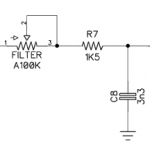

We can easily retune this filter by changing C8. Making C8 larger lowers the corner frequencies, allowing darker settings.
Another version of the low-pass filter is used in the Boss Blues Driver, Marshall BluesBreaker, M.I. Audio Crunch Box and some of the Cornish pedals. This is called a shelving filter; take a look at the curves below and you'll see why. The corner freq is constant, but the amount of cut is variable. This is the Cornish G-2 tone stack:

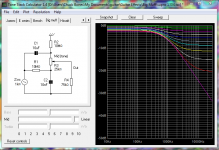
This filter can be retuned by changing C2 (in the TSC schematic). Larger darkens the filter and smaller makes it brighter. Changing the TONE pot to A-taper will make the bottom end of rotation less touchy.
Big Muff
The Big Muff tone stack shows up in more pedals than any other tone stack. It's a simple and effective combination TREBLE - BASS control. In its earlier incarnations, it had a mid notch that caused some users, myself included, to dislike it because we couldn't find a satisfactory setting. Here it is with the original component values and the dreaded mid notch. It's basically a high-pass filter (C1 & R2) and a low-pass filter (C2 & R1) in parallel with a blend control.
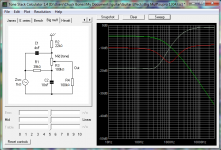
Boutique pedal builders will replace R2 with a pot or add switches to change the capacitors so that users can adjust the high-pass and/or low-pass corner frequencies. If the two corner frequencies are made equal, then the notch disappears.
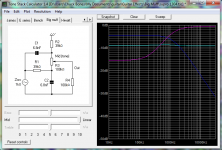
C1 & R2 affect the high-pass side of the filter. Making R2 smaller increases the bass cut. Making either or both C1 and R2 smaller moves the high-pass corner freq up, which deepens the mid notch and makes the tone hotter above noon. C2 & R1 set the low-pass corner freq. Making either or both smaller moves the corner freq up, increasing the midrange content. It's possible to create a mid hump by making the low-pass corner freq higher than the high-pass corner freq.
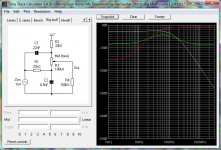
A variant on the Big Muff tone stack removes R2. The result is less bass cut when TONE is set above noon. The notch can be deepened or eliminated by varying the capacitor values. I use this in several of my pedal designs.
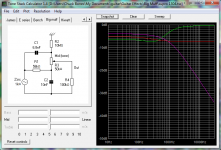
I'm almost at the limit for # of attached files, so on to part 1b...
Low-Pass Filter
The simplest tone stack is a low-pass filter. One way to implement it is how it's done in the Rat. The FILTER control varies the corner freq and R7 sets an upper bound to the corner freq.

Each line in the plot below corresponds to a setting of the FILTER knob from 0 to 10.
We can easily retune this filter by changing C8. Making C8 larger lowers the corner frequencies, allowing darker settings.
Another version of the low-pass filter is used in the Boss Blues Driver, Marshall BluesBreaker, M.I. Audio Crunch Box and some of the Cornish pedals. This is called a shelving filter; take a look at the curves below and you'll see why. The corner freq is constant, but the amount of cut is variable. This is the Cornish G-2 tone stack:

We can cajole TSC into simulating this tone stack by removing some parts from the Big Muff tone stack. I deleted R1 and R2 by making them very large and effectively jumpered C1 by making it very large.
This filter can be retuned by changing C2 (in the TSC schematic). Larger darkens the filter and smaller makes it brighter. Changing the TONE pot to A-taper will make the bottom end of rotation less touchy.
Big Muff
The Big Muff tone stack shows up in more pedals than any other tone stack. It's a simple and effective combination TREBLE - BASS control. In its earlier incarnations, it had a mid notch that caused some users, myself included, to dislike it because we couldn't find a satisfactory setting. Here it is with the original component values and the dreaded mid notch. It's basically a high-pass filter (C1 & R2) and a low-pass filter (C2 & R1) in parallel with a blend control.

Boutique pedal builders will replace R2 with a pot or add switches to change the capacitors so that users can adjust the high-pass and/or low-pass corner frequencies. If the two corner frequencies are made equal, then the notch disappears.

C1 & R2 affect the high-pass side of the filter. Making R2 smaller increases the bass cut. Making either or both C1 and R2 smaller moves the high-pass corner freq up, which deepens the mid notch and makes the tone hotter above noon. C2 & R1 set the low-pass corner freq. Making either or both smaller moves the corner freq up, increasing the midrange content. It's possible to create a mid hump by making the low-pass corner freq higher than the high-pass corner freq.

A variant on the Big Muff tone stack removes R2. The result is less bass cut when TONE is set above noon. The notch can be deepened or eliminated by varying the capacitor values. I use this in several of my pedal designs.

I'm almost at the limit for # of attached files, so on to part 1b...

